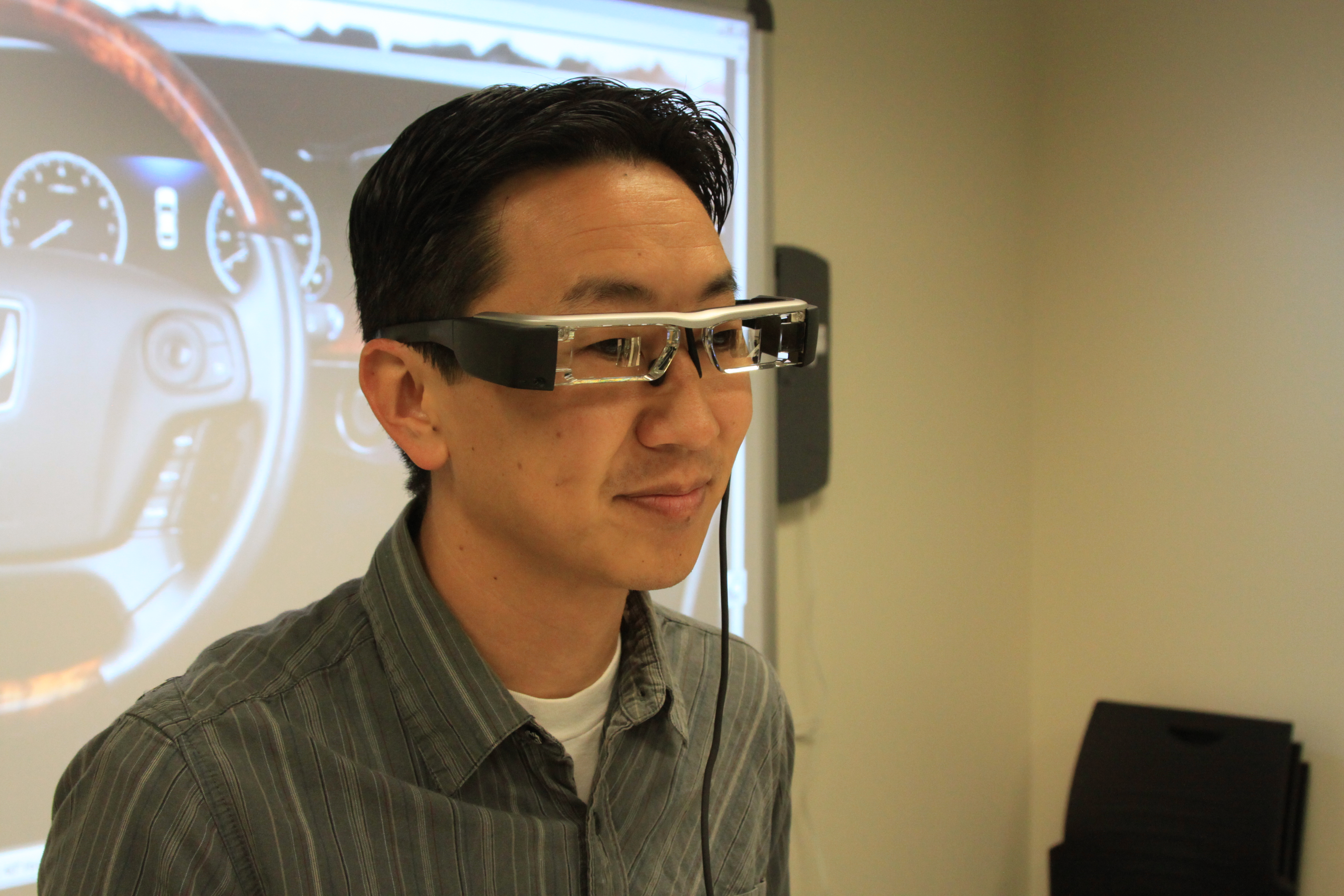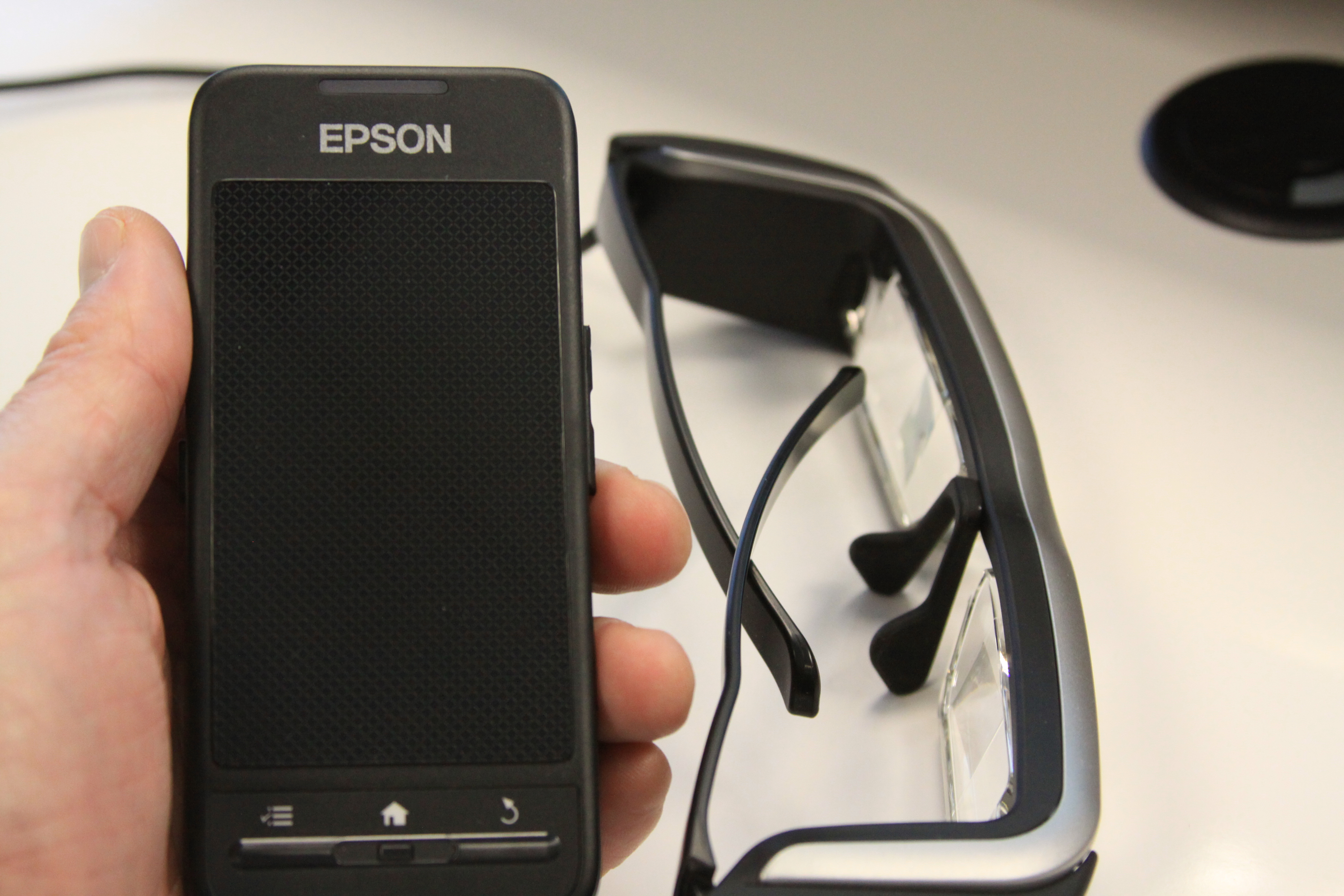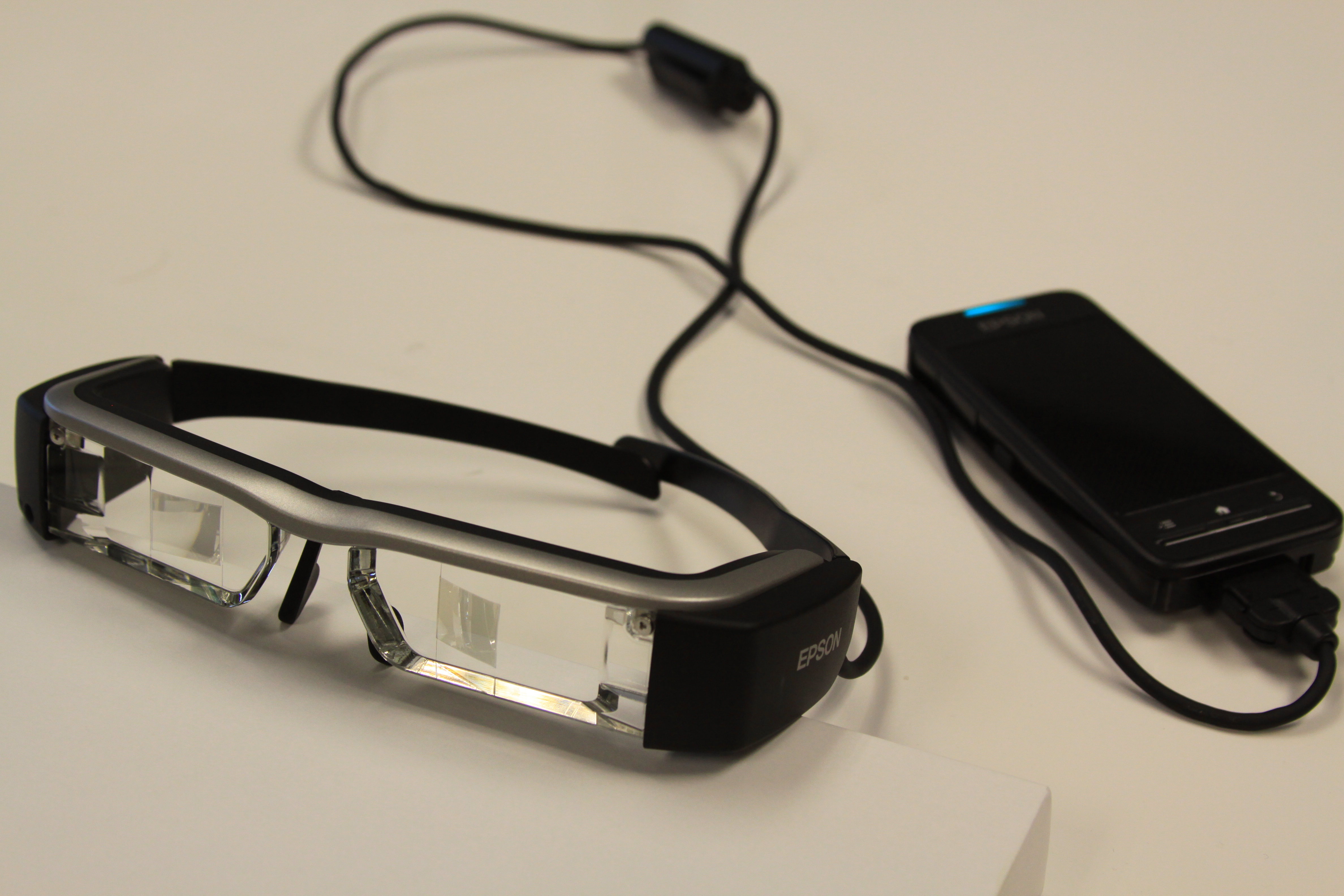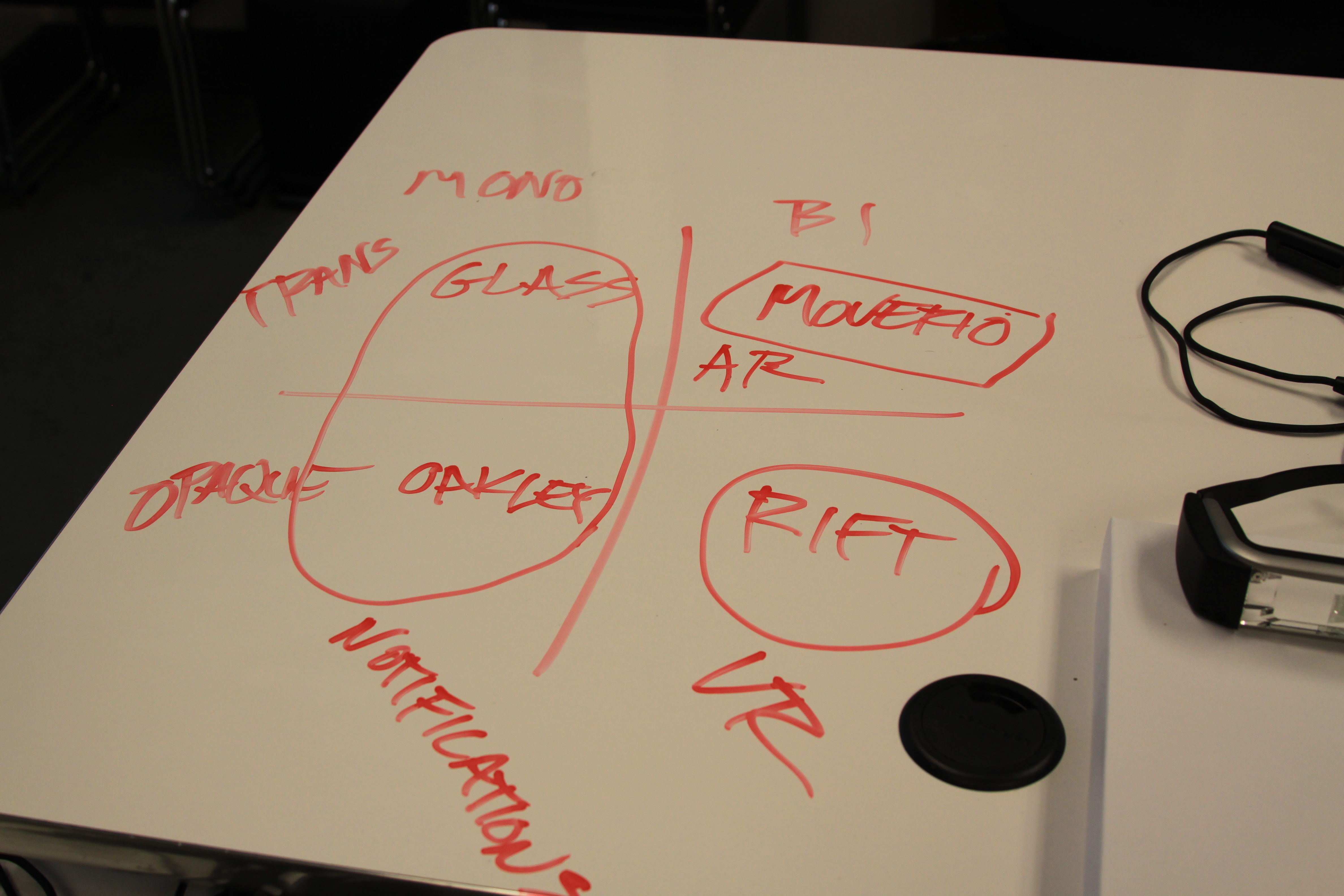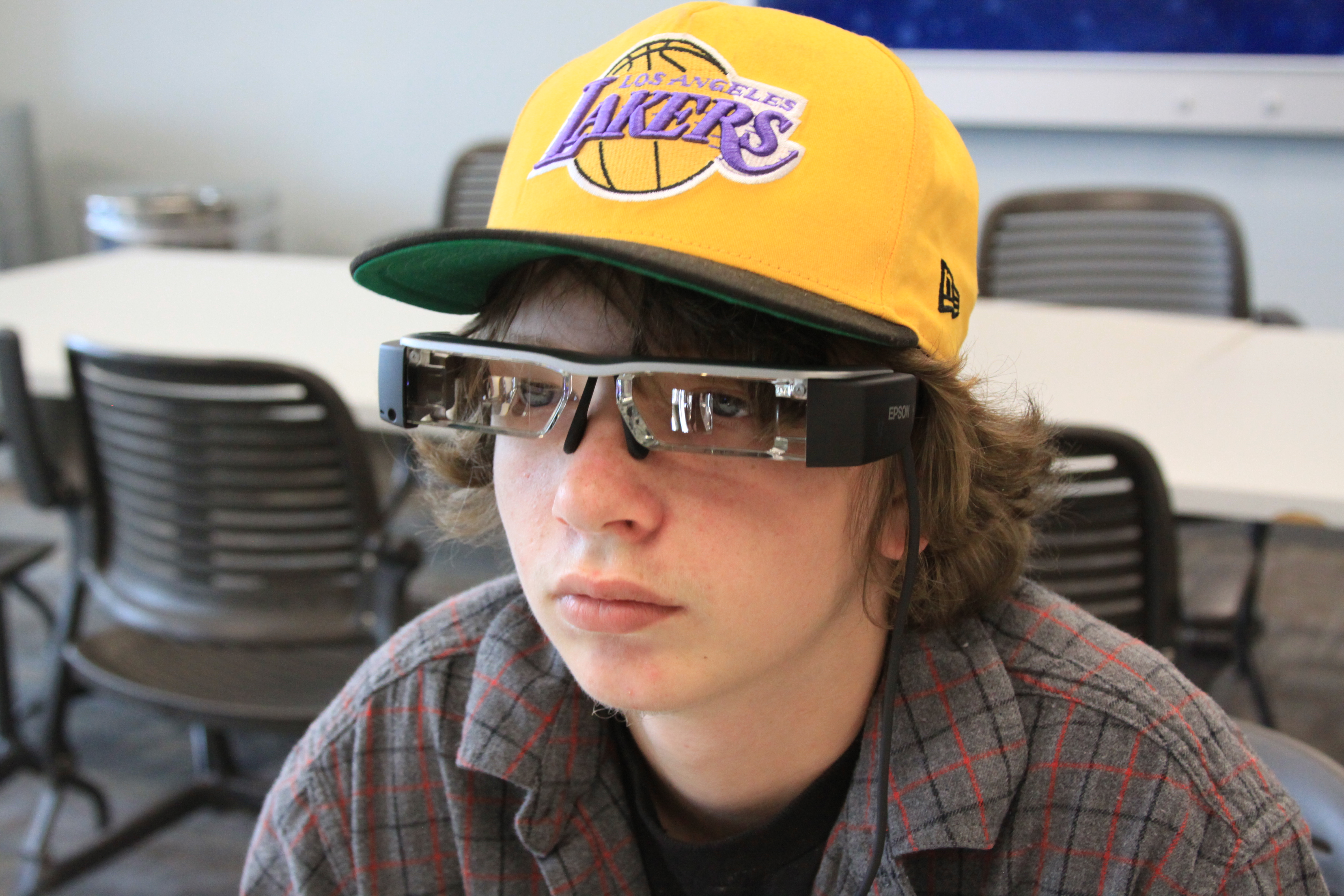Epson Moverio BT-200 AR Glasses In Person, Hands On
Epson's entry into augmented reality is more than just for fun and games.
Discard for a moment the notion that augmented reality is mostly for immersing yourself in games (I know, horrifying, but don't shoot the messenger), or that smart glasses are just for checking messages while pretending to be listening to a co-worker, or for stealthily taking creepy pictures of unsuspecting passersby (you know who you are). Instead, open up to the possibility that, thanks to augmented reality, common tasks like changing an oil filter or drawing blood or upgrading a laptop's memory will become easier, and that complex or time-consuming jobs like fixing an air conditioning unit or checking retail store shelves for product placement compliance will be simplified and more exact.
Welcome to the practical side of augmented reality, fueled in part by the concepts built into first-person games and the ongoing promise of Google Glass, but driven by more pedestrian applications, where heads-up displays or smart glasses will become just another piece of equipment, like a welding mask or hard hat or clipboard or bar-code scanner, and where it will matter less how they appeal to our vanity. After all, most of the early AR prototypes are dorky enough to make coke bottle glasses look like the latest Hollywood fashion.
This more practical augmented reality isn't just on its way, it's here now. This week Epson announced Moverio BT-200, the company's second generation augmented reality glasses, parlaying Epson's well-known projection technology into an exciting product that finally began fulfilling pre-orders, and is now on sale for $699 on the Epson store and through the company's enterprise partners. Epson won't say how many pre-orders it took, or how many new orders it is forecasting, but the numbers are apparently far greater than those of any of the crowdfunded devices.
I met with Eric Mizufuka, Epson's product manager for new markets, and Sean McCracken, CEO of Imaginary Computer and a developer of several AR and VR games and apps, at Epson America headquarters in Long Beach, CA, and I got to try the Moverio BT-200 glasses and some of the early applications for them. This wasn't meant to be a full-scale evaluation, just a chance to experience the product in a controlled setting and get a quick run through applications that Epson partners have developed so far.
Tom's Hardware's main LA office is close enough to both Epson and Oculus, and we'll be planning some more hands-on time with those companies, not to mention some of the other early AR and VR players we've begun to profile, so that we can begin to make more evaluative comparisons of the experiences and evolution of the technology.
The Moverio BT-200 are binocular smart glasses. The glasses contain two tiny projectors that create a qHD (960 x 540) and stereoscopic 3D display. The glasses include a front facing camera at VGA resolution, which might seem rather underwhelming but the camera is really more image sensor than photographic marvel. The camera is small, light, and pulls less power than the ones we've grown to expect on smartphones and tablets.
The glasses are attached to a control unit, a small, smartphone-sized device with a TI OMAP 4460 1.2 GHz dual-core processor, with 1 GB of RAM and 8 GB of internal storage capacity. Early discussions with other SoC providers didn't garner much interest, and in fact we've seen TI's technology in more than one of AR devices we've experienced. Surely others, like Nvidia, will jump in as the water warms up.
Get Tom's Hardware's best news and in-depth reviews, straight to your inbox.
The Moverio BT-200 control unit also includes WiFi, Bluetooth 3.0, microUSB, a touch pad (capacitive multi-touch), a slot for microSD, and runs Android 4.0. The control unit not only runs the glasses, including user interaction with them, but also supplies power -- up to six hours in an always-on capacity with its 2720 mAh battery.
The Moverio BT-200 includes a number of sensors acting as beacons and markers of the external environment: a GPS in the controller, a compass in the headset and controller, a gyroscope in both, an accelerometer in both, and of course the camera. The unit also contains a microphone.
Epson's Mizufuka explained that with augmented reality the head tracking does not need to be as precise (low latency) as it does with virtual reality, where you're fully immersed and anything that doesn't track on a one-to-one basis will seem off and induce motion sickness due to a lack of external context. Companies like Oculus VR have poured a tremendous amount of technology and science at the problem of latency, for very good reason, but Mizufuka said that because of these low latency requirements, technologies like Rift naturally must be tethered to high horsepower computing.
That doesn't mean that head tracking and minimizing latency isn't important, it's just that augmented reality can get away with less precision. In between the untethered Google Glass and the super-tethered Oculus, then, sits the Epson Moverio BT-200, tethered, but only minimally so.
The Moverio headset weighs 88g (less than .20 pounds), the controller 124g (about .27 pounds). The headset is 170 mm deep, 185 mm wide and 32 mm tall. The BT-200s are a second generation product, and, as such, it weighs about 60% of what the first generation weighed. Eric hinted at existing prototypes that will slip into your pocket, saying that the landscape is changing dramatically and quickly.
You can see a full list of the Epson Moverio BT-200 specifications here.
Unlike typical projectors, the Moverio glasses create more of an internal projection, forming a prism that converges the images and fools the eyes. Manufacturing these types of lenses is difficult to duplicate, and Epson's experience and expertise in precision manufacturing is a key differentiator, Mizufka said, giving the company an advantage in making them affordable and widely available.
Epson has also taken the time to attract enterprise partners. As part of this week's announcement, Epson emphasized partnerships with Metaio, APX Labs and WiPro (more on those below). And for its part, Metaio announced a beta SDK of its own, which adds the ability to create transparent AR rendering, high-definition rendering for iOS devices and face-detection algorithms. In other words, the AR ecosystem is growing right before our eyes, if you'll pardon the pun.
Another interesting part of the ecosystem includes the third-party peripherals market (or if you think of AR and VR devices as peripherals, then these would be peripherals once removed). Those peripherals include depth-sensor cameras and specialized gloves, rings and bracelet-style devices that enable gesture input, including the intriguing Thalmic Labs Myo Controller, which McCracken demonstrated in conjunction with a Moverio BT-200 application. The Myo Controller has a gyroscope, accelerometer and magnetometer, and can detect motion, but can also pick up electrical impulses in your muscles, like when you're making a fist, or extending a finger. It's still just available as a developer kit, but it sure whets the appetite.
Epson, like its many competitors, realizes that success is intricately tied to applications. Mizufuka is quick to acknowledge that while Google Glass followed Epson's first generation device (2011), Google accelerated the conversation in a way that lifted everyone. Unity 3D, the popular multiplatform game engine, also promises to fuel development, since the engine can be used to develop iOS, Android and desktop games, as well as ones that will take advantage of products like Oculus Rift and Moverio. Mizufuka also acknowledges that VR, and the attention Oculus has thrust onto the scene has awoken developers to the possibility of 3D worlds, of using head tracking as a medium, of building applications from a first person perspective.
One of the Imaginary Computer games I played was Psyclops, a simple first person game where the object is to kill aliens, which attack from 360 degrees. By moving my head I could see the aliens coming, above me, behind me, and I could tap on the control unit track pad to shoot them. Black turns transparent, so it was a little like looking through sunglasses. I was immersed in the virtual game, but also aware of my actual surroundings. The following video gives a feel for Psyclops.
The Moverio field of view is finite, at 23 degrees, but the head tracking makes the immersion feel more infinite. McCracken showed me a prototype where he used the outer edges of that field of view to stick Facebook, Instagram and Twitter cubes. Using the Myo Controller, you can use a gesture to move a cursor over the Facebook button and activate it upon hovering. The demonstration gave us a little trouble because of some Bluetooth connectivity issues, but the general idea is to have a 3D cursor in space, accessing functions without having to switch screens or displays. "I could make an infinite 3D desktop," McCracken said, adding that everything could theoretically enter your field of view, allowing you to virtually grab objects, Minority Report style, but from wherever you are rather than stuck in front of a screen. The general idea of the demonstration is captured in the video below.
Even Moverio's less powerful (compared to VR displays) head tracking would make something like Google Glass overheat, McCracken said, which is why Glass input is primarily voice command or a physical touch. McCracken, who has developed for Glass, said that more advanced uses can only be accomplished with something more powerful. (Both Mizufuka and McCracken are quick to point out that Google Glass is excellent for its intended use, being careful not to make competitive comparisons, but to point out the different use cases between Glass and Moverio.)
Where Psyclops was built originally for Google Glass and made to work with Moverio, Skytemple, another Imaginary Computer game, is built for Moverio. I wasn't allowed to enter the game itself, only to view the opening trailer, which was an incredibly immersive experience in a much more detailed graphic world. McCracken wanted me to see the level of immersion and graphic quality that Moverio is capable of. But I also have little to compare that with, so I will leave evaluative commentary for later--still, it was undoubtedly impressive.
McCracken said that devices like Oculus Rift will appeal to the hard core gamers, people who are into the first person shooters and graphic intensive games. He sees Moverio's gaming as more of a Wii type experience, something for the more casual gamer.
Mizufuka said Epson was demonstrating a 3D tabletop fighter game from Namco Bandai at GDC. In that concept game, called Sketchbook Fantasy, multiple players interact with 3D content projected into the real world, with dragons lighting players on fire before your very virtual eyes. Unfortunately someone stole the unit that was running the game, so, alas, I was unable to experience this one either. Nor I was unable to get my hands on any footage.
The following video is an interesting look at an AR experience using the Phantom Drone 2 Vision +, where the Moverio BT-200 glasses are live streaming the drone's camera feed. The potential for this technology is readily apparent.
We moved from gaming to serious enterprise applications, starting with Epson's work with Metaio, a leading AR development platform. Metaio enables true augmented reality, where content is projected over a physical object. One prominent example, which I had previously witnessed for the first time at CES in January, was fixing an AC unit. The Moverio glasses and the application uses edge tracking, detecting the outlines of an object (the AC unit), and overlaying real instructions upon it, allowing a technician to find, repair or replace parts. Epson and Metaio are working on this for Mitsubishi, but the idea is to add other complicated repair jobs.
Epson is also working on the retail front. Global technology consultancy, WiPro, created an app called a Planogram, and field reps whose companies have paid slotting fees on retail store shelves can validate whether packaged goods are in the right place, ensuring the retailer is in compliance. The field rep merely looks at shelf and sees what's in compliance and what isn't, using an overlay of check marks. The rep can, hands free, see what's out of place and start re-arranging products on the fly. The program actually fills out a spreadsheet, noting the compliance status, takes a picture, and submits a compliance report, all hands free, all using only visual recognition.
APX Labs Lighthouse built an application for the auto industry, where a potential buyer can get more information, in 3D, about a car without having to deal with those pesky sales people. The 3D information comes to life when you look at the items in the car, offering more details, operating instructions or even a video. The idea -- to create hot spots that can exist over people, places or things -- can apply to anything, naturally.
Another example on the list of things Epson couldn't get working during my visit was streaming between glasses. The example Epson wanted to show was a service technician calling back to an office and getting help from someone more advanced, a sort of over-the-shoulder coach. Like the Myo Controller demonstration, this was also just a connectivity issue.
McCracken predicts that augmented reality is still a few years away from mass consumption, or as he puts it: "We haven't had our iPhone moment yet." But he has tried all of the existing VR and AR technologies being sold or prototyped today, including ones we haven't heard about yet, he says, and the Moverio BT-200s have the best optics he has experienced in that these glasses are applicable to almost every use case imaginable.
And that's really the point. Google Glass is specialized as a notification engine, and technology like the Oculus Rift is specialized as an immersive, high quality graphics display. Epson's goal appears to be taking more of a horizontal approach, seeking broad applicability.
Because the Moverio BT-200s will be used for particular tasks, their size, style and tethering aren't the burdens they might ordinarily seem to be. Because augmented reality assumes an external context, latency isn't quite as important, either. In the picture below Mizufuka draws out the Epson view of the VR and AR market, in the form of a quadrant, with mono and bifocal as the columns, and transparent and opaque as the rows. Naturally Epson occupies the upper right -- hey, it's Epson's drawing, what would you expect? The company is betting that its particular square will yield the broadest interest.
Quadrants and hype and demos aside, the Moverio BT-200s are available for purchase now. They cost less than half of what a pair of Google Glass costs, and $300 less than the Vuzix M100. Yet the Moverio augmented reality glasses are still very much developer focused for now.
The kids think it's cool, though.
MORE: The Past, Present, And Future Of VR And AR: The Pioneers Speak
Follow Fritz Nelson @fnelson. Follow us @tomshardware, on Facebook and on Google+.
-
Blazer1985 Very nice article Fritz, but for the sake of the legendary attention of tom's reader to typos I have to point out that the resolution is qHD or quarter hd, not QHD or quad hd.Reply -
clonazepam I need these like yesterday if Im going to fix my car's transmission (and every other little problem that comes up) by myself! =)Reply
Were you next to the breakroom? Maybe someone was microwaving some popcorn right next door. Had that happen from time to time during product demos over there lol -
ddpruitt I want to say thanks to all of those companies out there creating these geeky toys that those of us who wear real glasses can't use, you know that large portion of your user base you're ignoring. These look interesting if I would be able to use them.Reply
Thanks for all the LOVE! -
FritzEiv Blazer1985 -- thanks for the catch! Fixed. Clonazepam, we were in the lab where they do these demos all the time. I think on the streaming video ones it was more of a server issue.Reply
